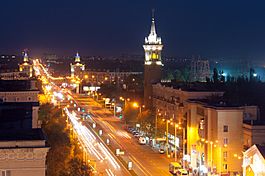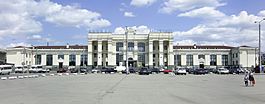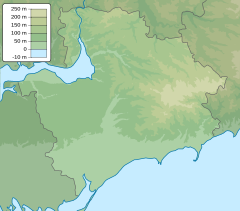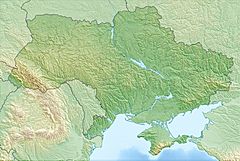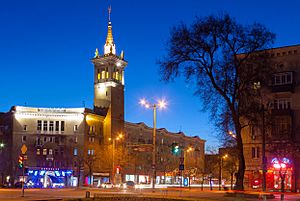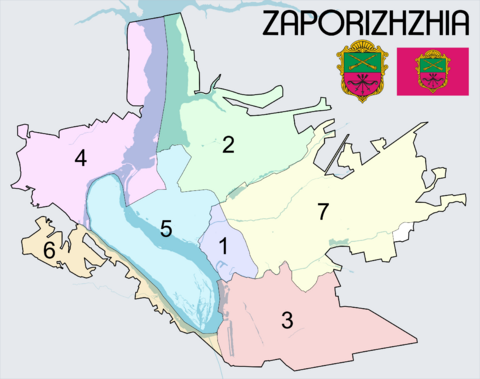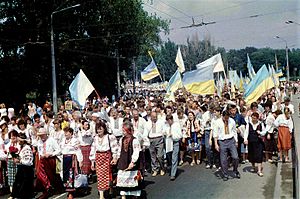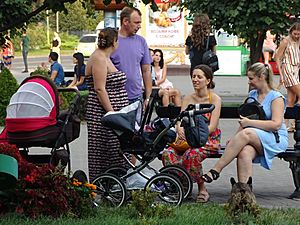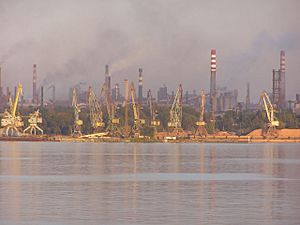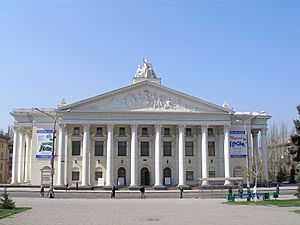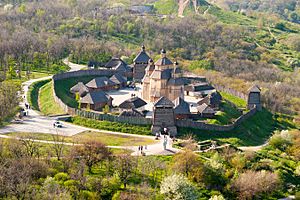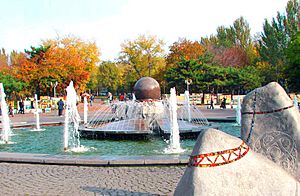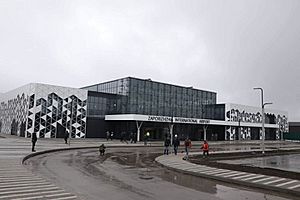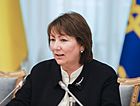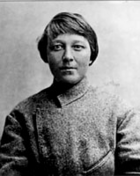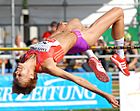Zaporizhzhia facts for kids
Quick facts for kids
Zaporizhzhia
Запоріжжя
|
|||||
|---|---|---|---|---|---|
| Ukrainian transcription(s) | |||||
| • National/"BGN/PCGN" | Zaporizhzhia | ||||
| • ALA-LC | Zaporiz͡hz͡hi͡a | ||||
| • Scholarly | Zaporižžja | ||||
|
From top to bottom and left to right:
|
|||||
|
|||||
| Country | |||||
| Oblast | Zaporizhzhia Oblast | ||||
| Raion | Zaporizhzhia Raion | ||||
| Hromada | Zaporizhzhia urban hromada | ||||
| Founded | 1770 | ||||
| City rights | 1806 | ||||
| Raions |
7
Zavodskyi District
Khortytskyi District Komunarskyi District Dniprovskyi District Oleksandrivskyi District Voznesenskyi District Shevchenkivskyi District |
||||
| Area | |||||
| • City | 334 km2 (129 sq mi) | ||||
| • Metro | 4,675 km2 (1,805 sq mi) | ||||
| Population
(2022)
|
|||||
| • City | 710,052 | ||||
| • Density | 1,365.2/km2 (3,536/sq mi) | ||||
| • Metro | 840,866 | ||||
| Time zone | UTC+2 (EET) | ||||
| • Summer (DST) | UTC+3 (EEST) | ||||
| Postal code |
69xxx
|
||||
| Area code(s) | +380 61(2) | ||||
| Climate | Dfa | ||||
Zaporizhzhia (Ukrainian: Запоріжжя) is a big city in southeastern Ukraine. It sits right on the banks of the Dnieper River. This city is the main center for the Zaporizhzhia Oblast region. About 710,000 people live in Zaporizhzhia.
The city is famous for the historic Khortytsia island and its many power plants. It's also a very important place for industry. Things like steel, aluminum, airplane engines, and cars are made here.
Contents
- Understanding the Name of Zaporizhzhia
- A Look at Zaporizhzhia's Past
- Exploring Zaporizhzhia's Geography
- How Zaporizhzhia is Governed
- People of Zaporizhzhia
- Zaporizhzhia's Economy
- Culture and Arts in Zaporizhzhia
- Top Places to Visit
- Getting Around Zaporizhzhia
- Famous People from Zaporizhzhia
- Sister Cities
- Images for kids
- See also
Understanding the Name of Zaporizhzhia
The name Zaporizhzhia means "beyond the rapids." This is because the city is located downstream, or south, of the Dnieper Rapids. These rapids used to make it hard for boats to travel. People often had to carry their boats and goods around them.
In 1932, the rapids were covered by water when the Dnieper Hydroelectric Station was built. Before 1921, the city was called Oleksandrivsk. This name came from an old fortress that was part of the Dnieper Defence Line of the Russian Empire.
A Look at Zaporizhzhia's Past
Zaporizhzhia was started in 1770. Back then, it was a fortress called Aleksandrovskaya. Its purpose was to protect the southern lands of the Russian Empire from attacks. After a peace treaty in 1775, the fortress was no longer needed for military defense. It became a small town called Alexandrovsk until around 1930.
Growing into an Industrial City
The city began to grow a lot when the Kichkas Bridge opened in the early 1900s. This was the first railway bridge across the Dnieper River. During World War I, an airplane engine factory moved to Zaporizhzhia.
In the 1920s and 1930s, the Soviet government made Zaporizhzhia even more industrial. They built the Dnieper Hydroelectric Station, the Zaporizhzhia Steel Plant, and the Dnieper Aluminium Plant. An American company also built a large steel mill that could produce a lot of steel each year.
Zaporizhzhia During World War II (1941–1945)
When the war between the USSR and Nazi Germany began in 1941, factories in Zaporizhzhia were moved to Siberia. On August 18, 1941, German forces reached the city and took over Khortytsia island.
The Red Army blew up a part of the Dnieper hydroelectric dam. This caused a huge flood that swept through the area. Many people, including soldiers from both sides, died in this flood. German forces fully took over Zaporizhzhia on October 3, 1941. During their two-year occupation, many people were killed or sent away for forced labor.
In 1943, the Germans set up their army headquarters in Zaporizhzhia. Even Adolf Hitler visited the city. But in October 1943, the Soviet army launched a surprise night attack and took back most of the city.
Modern Zaporizhzhia (1991–Present)
In 2004, work started on a new bridge over the Dnieper River to help with traffic. However, construction stopped due to a lack of money.
In 2016, a law was passed in Ukraine to remove names and symbols from the Soviet era. Because of this, Zaporizhzhia renamed over 50 streets and removed monuments of Soviet leaders.
The Russian Invasion (2022)
Russian forces have been attacking Zaporizhzhia since the start of the 2022 Russian invasion of Ukraine. In February 2022, fighting was reported, and Russian forces shelled the city. While Russia occupied parts of the Zaporizhzhia region, they did not take the city itself.
On March 3, Russian forces got close to the Zaporizhzhia Nuclear Power Plant, which caused worries about a nuclear accident. Later, in September and October 2022, Russian forces launched missile attacks on the city. These attacks hit a civilian convoy and residential buildings, causing many deaths.
Exploring Zaporizhzhia's Geography
Zaporizhzhia is located in southeastern Ukraine. The Dnieper River flows through the city, splitting it into two parts. In the middle of the river is Khortytsia Island. The city covers about 334 square kilometers.
Khortytsia Island is about 12 kilometers long and 2 kilometers wide. The Dnieper River splits around it into the New Dnieper (about 800 meters wide) and the Old Dnieper (about 200 meters wide). Smaller rivers also flow into the Dnieper within the city.
Nature on Khortytsia Island
The plants and animals on Khortytsia Island are very special. This is because of the dry air and the large freshwater river, which helps clean the air from nearby industries. The island is a national park. It has many deep valleys, hiking trails, and historical sites. Khortytsia is a popular place for people to relax, with health centers and sandy beaches.
Zaporizhzhia's Climate
Zaporizhzhia has a climate with warm summers and cold winters. The average temperature in January is around -3.1°C, and in July, it's about 23.2°C. The city gets about 515 millimeters of rain each year.
How Zaporizhzhia is Governed
Zaporizhzhia is the main city of the Zaporizhzhia Oblast region. It has its own local government. The city is divided into 7 different districts.
|
|
People of Zaporizhzhia
The number of people living in Zaporizhzhia has been going down since Ukraine became independent. In January 2017, the population was 750,685.
Ethnic Backgrounds
According to the 2001 census, most people in Zaporizhzhia are Ukrainians (70.28%). The next largest group is Russians (25.39%). Other groups include Belarusians, Bulgarians, Jews, and Georgians.
Languages Spoken
Ukrainian is the official language used for government business. However, many people in Zaporizhzhia also speak Russian. In 2001, about 41.6% of people spoke Ukrainian as their first language, and 56.8% spoke Russian.
Religions in Zaporizhzhia
Many different religions are practiced in Zaporizhzhia.
- Christianity: Most citizens are Orthodox Christians. The Church of the Intercession is a popular Orthodox church. There are also Protestant churches (like Baptists and Adventists) and Catholic churches.
- Judaism: There are several Jewish communities in the city.
- Islam: There are Muslim communities in the Zaporizhzhia area.
- Hinduism: The city also has a branch of the Vedic Academy.
Zaporizhzhia's Economy
Major Industries
Zaporizhzhia is a very important industrial city in Ukraine. It's home to the country's main car manufacturing company, Zaporizhzhia Automobile Factory, which makes cars like Zaporozhets and Tavria. The city also has Motor-Sich, a company that makes aircraft engines.
Because there's a lot of electricity, coal, iron ore, and manganese nearby, Zaporizhzhia is a major center for heavy industries. These include metallurgy (working with metals), aluminum, and chemical industries. The city's port is also important for moving goods from the Donbas region. Zaporizhstal, one of Ukraine's largest steel makers, is based here.
Electricity Production
Zaporizhzhia is a big hub for making electricity. It has the "DniproHES" hydroelectric power plant and the largest nuclear power plant in Europe, the Zaporizhzhia Nuclear Power Plant. Before the 2022 invasion, these plants produced about 25% of Ukraine's electricity.
Culture and Arts in Zaporizhzhia
Zaporizhzhia has a rich cultural scene. It has an orchestra, many museums, theaters, and libraries. Some popular places include:
- The Magara Academic Drama Theatre
- The Theatre for Young-Age spectators
- The Theatre of Horse Riding "Zaporizhzhian Cossacks"
- The Zaporizhzhia Regional Museum
- The Motor Sich Aviation Museum
The city also has many small groups that perform folk music and art galleries. Festivals, Cossack martial arts competitions, and art exhibitions happen regularly. You can often find local artists selling their work and showing how they create it near the 'Fountain of Life' at Mayakovsky Square.
Top Places to Visit
The historical and cultural museum "Zaporizka Sich" is on the northern part of Khortytsia Island. This museum is a rebuilt version of a Cossack stronghold. It shows what their military camps and daily lives were like.
The smaller islands around Khortytsia Island have interesting legends. One island, called Durnya Scala ("Rock of the Fool"), is said to be where Tzar Peter the Great punished Cossacks. Another island, Stolb ("Pillar"), has a large bowl-like shape in its granite rocks. People say the Cossacks used this "Cossack's Bowl" to cook food.
Getting Around Zaporizhzhia
Zaporizhzhia is a key transportation hub in Ukraine. It has roads, railways, river routes, and air links for both people and goods. The Zaporizhzhia International Airport handles flights within Ukraine and to other countries.
Major highways pass near Zaporizhzhia, connecting it to other important cities like Kharkiv, Kyiv, and Mariupol. There are four road bridges and two rail bridges that cross the Dnieper River, mostly going over Khortytsia Island. A new bridge, the New Zaporizhzhia Dniper Bridge, started opening in 2022.
The city has two train stations: Zaporizhzhia-1 and Zaporizhzhia-the-Second. Zaporizhzhia-1 is the main station. The city also has a large tram network with 7 lines.
Zaporizhzhia's two river ports are part of Ukraine's water transportation system. They connect the city to Kyiv and Kherson along the Dnieper River.
Famous People from Zaporizhzhia

Many talented people come from Zaporizhzhia, including:
- Alyosha (born 1986), a Ukrainian singer.
- Valentyna Danishevska (born 1957), a Ukrainian lawyer and judge.
- Alina Gorlova (born 1992), a Ukrainian filmmaker.
- Gosha Kutsenko (born 1967), a Russian actor and singer.
- Maria Nikiforova (1885–1919), a revolutionary leader.
- Estas Tonne (born 1975), a musician.
Sports Stars from Zaporizhzhia
Zaporizhzhia has produced many great athletes:
- Polina Astakhova (1936–2005), an artistic gymnast who won ten Olympic medals.
- Anastasia Bliznyuk (born 1994), a Russian rhythmic gymnast.
- Yakiv Punkin (1921–1994), a wrestler who won an Olympic gold medal.
- Vita Styopina (born 1976), a high jumper who won an Olympic bronze medal.
- Denys Sylantyev (born 1976), a swimmer and politician who won an Olympic silver medal.
Sister Cities
Zaporizhzhia is twinned with several cities around the world. This means they have special friendly relationships and often share culture and ideas.
 Lahti, Finland (1953)
Lahti, Finland (1953) Belfort, France (1967)
Belfort, France (1967) Birmingham, United Kingdom (1973)
Birmingham, United Kingdom (1973) Linz, Austria (1983)
Linz, Austria (1983) Oberhausen, Germany (1986)
Oberhausen, Germany (1986) Yichang, China (1997)
Yichang, China (1997) Magdeburg, Germany (2008)
Magdeburg, Germany (2008) Ashdod, Israel (2011)
Ashdod, Israel (2011) Steinbach, Canada (2018)
Steinbach, Canada (2018)
In 1969, Zaporizhzhia named a street after the city of Wrocław in Poland. Wrocław returned the favor by naming a street "Zaporoska Street."
Images for kids
See also
 In Spanish: Zaporiyia para niños
In Spanish: Zaporiyia para niños


